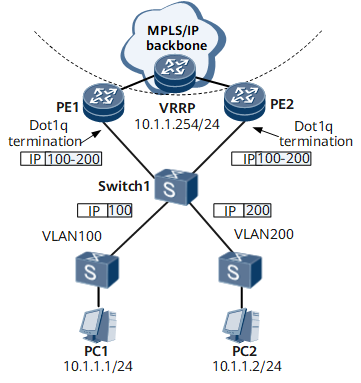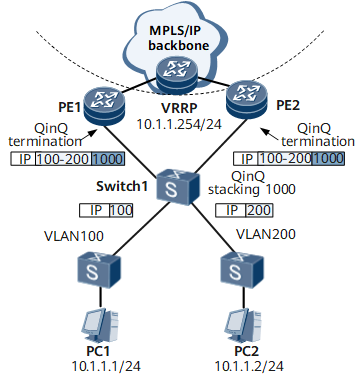VRRP on a Termination Sub-interface
On the network shown in Figure 1 and Figure 2, Virtual Router Redundancy Protocol (VRRP) is supported on termination sub-interfaces to ensure communication between Dot1q or QinQ users and networks.
VRRP can be configured on a sub-interface for Dot1q VLAN tag termination or sub-interface for QinQ VLAN tag termination, based on whether the user packets received by a PE contain one or two VLAN tags.
If the user packets contain one tag, the sub-interface that has VRRP configured is a sub-interface for Dot1q VLAN tag termination.
If the user packets contain double tags, the sub-interface that has VRRP configured is a sub-interface for QinQ VLAN tag termination.
VRRP on a Sub-interface for Dot1q VLAN Tag Termination
On the network shown in Figure 1, sub-interfaces for Dot1q VLAN tag termination specify an outer tag, such as tag 100, to configure a VRRP group.
Maintaining the master/backup status of the VRRP group
Responding to ARP request messages of users
The PE responds to ARP requests of users regardless of whether their packets contain the tag specified during the VRRP configuration.
Updating the MAC address entries of the Layer 2 switch
Gratuitous ARP messages are sent periodically to update the MAC entries of the switch and are copied for all the VLAN tags specified on the sub-interfaces for Dot1q VLAN tag termination. In this way, the VLANs on the switch can learn virtual MAC addresses. To improve system performance, the frequency of sending gratuitous ARP messages is increased only when a master/backup switchover is performed. During stable operation of VRRP, the frequency of sending gratuitous ARP messages is lowered, and the interval at which gratuitous ARP packets are sent must be less than the aging time of MAC entries on the switch.
The preceding working mechanism has the following advantages:
Only one VRRP instance needs to be created for users on the same network segment, even if they carry different VLAN tags.
VRRP resources are saved.
Hardware resources are saved.
IP addresses are saved.
The number of users that can access the network is increased.
VRRP on a Sub-interface for QinQ VLAN Tag Termination
On the network shown in Figure 2, sub-interfaces for QinQ VLAN tag termination specify double tags, such as an inner tag 100, outer tag 1000 to configure a VRRP group.
Maintaining the master/backup status of the VRRP group
Responding to ARP request messages of users
The PE responds to ARP requests of users regardless of whether their packets contain the tags specified during the VRRP configuration.
Updating the MAC address entries of the Layer 2 switch
Gratuitous ARP messages are sent periodically to update the MAC entries of the switch and are copied for all the VLAN tags specified on the sub-interfaces for QinQ VLAN tag termination. In this way, the VLANs on the switch can learn virtual MAC addresses. To improve system performance, the frequency of sending gratuitous ARP messages is increased only when a master/backup switchover is performed. During stable operation of VRRP, the frequency of sending gratuitous ARP messages is lowered, and the interval at which gratuitous ARP packets are sent must be less than the aging time of MAC entries on the switch.
The preceding working mechanism has the following advantages:
Only one VRRP instance needs to be created for users on the same network segment, even if they carry different VLAN tags.
VRRP resources are saved.
Hardware resources are saved.
IP addresses are saved.
The number of users that can access the network is increased.

